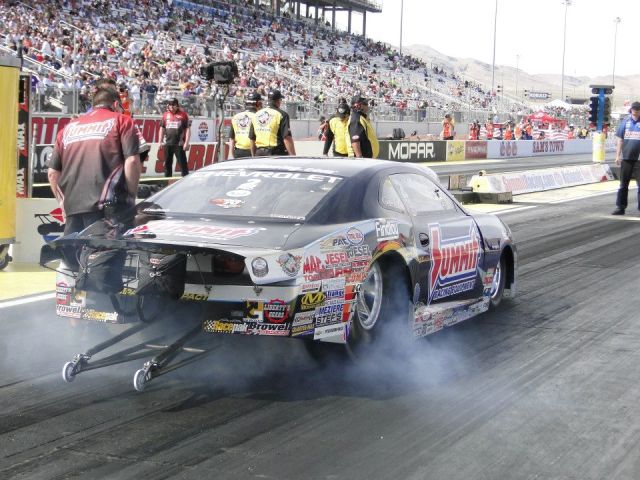How does Warren Johnson seem to squeeze every last ounce of power from his engines? What is the secret to Greg Anderson’s consistency race in and race out?
Those are good questions. And we’ve got good answers, because guys like Anderson, Don Garlits, and other accomplished professional and sportsman racers have shared some of the secrets to their incredible success with us. Read and learn as they take you from pre-race preparation to the finish line over the next few weeks. This second part of our series is all about vehicle mechanics and how to make proper adjustments to the conditions.
Performance, and ultimately elapsed time, is largely the result of horsepower, acceleration, and traction. Striking the right balance between these factors can be tricky, but some pro racers have built their reputations on their mechanical skills and their ability to make adjustments based on weather and track conditions. Our panel of seasoned race veterans share these 12 tips that have helped them along the way:
1. “When building or assembling an engine, take the necessary time to pinpoint Top Dead Center, because the effectiveness of future timing and valvetrain adjustments depends on it. ” —Larry Morgan, NHRA Pro Stock Driver
2. “For best overall performance, turn the engine five percent over its peak power rpm at the finish line. For example, if your engine produces peak power at 9,000 rpm, you’ll want to cross the finish stripe at approximately 9,450 rpm.” —Warren Johnson, NHRA Pro Stock Driver
3. “Bite and wheel speed can be significantly influenced by tire pressure—as little as 1/10 pound increments. More tire pressure equals more bite, a more uniform contact patch, and less wheel speed. Less tire pressure equals less initial traction, less uniform contact.” —Warren Johnson, NHRA Pro Stock Driver
4. “Corrected altitude and track temperature are the two most critical areas to watch while tuning your race car. As corrected altitude goes up, you may need to change rear gear ratio, timing, or jetting.” —Kurt Johnson, NHRA Pro Stock Driver
5. “If your car begins running slower in cool weather, it’s probably time to up your carburetor jet size.” —Clay Millican, NHRA Top Fuel Driver
6. “Keep a log of track temperature versus 60 foot times to help your ET dial in. You may need to adjust the starting line rpm to help keep your 60 foot times more consistent. The hotter the track, the lower the rpm in general.” —Greg Anderson, NHRA Pro Stock Driver
7. “I see many needless oil downs at the track. Most are avoidable by simply tightening all fluid connections, examining hoses, checking bolt torque, etc. Be courteous to your fellow racers—check your racecar over good before you run.” —Tim Wilkerson, NHRA Funny Car Driver
8. “In sportsman racing, where horsepower is limited, you can make more use of your available horsepower by pairing smaller diameter tires with a larger gear ratio. It takes more power to spin a larger tire than it does a larger gear. Therefore, you can save horsepower with the smaller tires and apply to the differential to achieve a performance boost.” —Don Garlits, Legendary Top Fuel Driver
9. “A lot of guys underestimate the importance of their front tires, but front tire pressure has a huge bearing on how a race vehicle handles on the track. As a general rule of thumb, the rougher the track, the lower the front tire pressure should be. On a smoother track, front tire pressure should be higher. By following that simple formula, your racecar will handle and perform its best under the given conditions.”
—Larry Morgan, NHRA Pro Stock Driver
10. “Most guys under-inflate their rear slicks—by up to ½ pound in some cases. If you experience tire spin off the starting line, add more pressure to your rear tires. The extra pressure will give you increased bite at launch and help you stay glued to the track.” —Larry Morgan, NHRA Pro Stock Driver
11. “Improper piston-to-valve clearance can, at best, lead to poor performance, and at worst, cause costly engine damage. Here’s a quick way to double check piston-to-valve clearance without removing the cylinder heads: take an old spark plug, drill and tap the end, and insert a bolt so that it sticks out about 3/4 of an inch further than original plug end. Insert the spark plug into the plug hole on the cylinder head and rotate the crankshaft slowly each way, making sure the piston and valve clear the bolt.” —Larry Morgan Driver, NHRA Pro Stock
12. “Follow these general correction factors:
7-second car 10-second car 15-second car
1 degree of air temperature: .0023 ET .0032 ET .0049 ET
.1 in Hg barometer: .0072 ET .0100 ET .0154 ET
These changes in ET are for air quality only. You will also need to monitor track temperature to see its effects on your ET.” —Rob Downing, NHRA Pro Stock Crew Chief
Don’t forget to check out our post on essential track tools to make the proper adjustments at your next race.


Comments